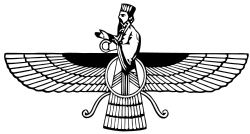
Back فيريثراجنا Arabic Verethragna Czech Verethragna German بهرام Persian Verethragna French Verethragna ID ウルスラグナ Japanese 베레트라그나 Korean Veretragna Lithuanian Veretragna Portuguese
This article includes a list of general references, but it lacks sufficient corresponding inline citations. (September 2024) |
| Verethragna | |
|---|---|
God of War and Victory Barrier-Breaker | |
 Relief of the God Varahram on a column in Taq-e Bostan, Sassanian period | |
| Avestan | Verethragna 𐬬𐬆𐬭𐬆𐬚𐬭𐬀𐬖𐬥𐬀 |
| Affiliation | The Thirty-Three Deities, Guardians of the Days of the Month |
| Planet | Mars |
| Symbol | White Horse, Strong wind, Wild Boar, Camel, Bull, Young Man, Ram, Wild Goat, Magnificent Armed Man, Bird of Prey |
| Sacred flower | Hyacinth |
| Day | 20th of each month in the Iranian calendar, Tuesday of each week |
| Gender | male |
| Associated deities | Mithra, Tishtrya, Vayu-Vata |
| Equivalents | |
| Greek | Ares |
| Roman | Mars |
| Part of a series on |
| Zoroastrianism |
|---|
 |
|
|
Verethragna or Bahram (Avestan: 𐬬𐬆𐬭𐬆𐬚𐬭𐬀𐬖𐬥𐬀, romanized: vər-ə-θraɣna) is a Zoroastrian deity.[1][2]
The neuter noun verethragna is related to Avestan verethra, 'obstacle' and verethragnan, 'victorious'.[3] Representing this concept is the divinity Verethragna, who is the hypostasis of "victory", and "as a giver of victory Verethragna plainly enjoyed the greatest popularity of old."[4] In Zoroastrian Middle Persian, Verethragna became 𐭥𐭫𐭧𐭫𐭠𐭭 Warahrām, from which Vahram, Vehram, Bahram, Behram and other variants derive.
The Proto-Aryan adjective *vrtraghan, which corresponds to the Avestan noun Verethragna, also has an etymological cognate in Vedic Sanskrit - Vrtra. In Vedic literature, Vrtrahan is predominantly an epithet used for Indra[5] after he defeated Vrtra. Vrtrahan literally means "slayer of Vrtra."
The name and, to some extent, the deity was borrowed into Armenian Վահագն Vahagn and Վռամ Vṙam, and has cognates in Buddhist Sogdian 𐫇𐫢𐫄𐫗 wšɣn w(i)šaɣn, Manichaean Parthian 𐭅𐭓𐭉𐭇𐭓𐭌 wryḥrm Wahrām, Kushan Bactrian ορλαγνο Orlagno.[6] While the figure of Verethragna is highly complex, parallels have also been drawn between, Puranic Vishnu, Manichaean Adamas, Chaldean / Babylonian Nergal, Egyptian Horus, Hellenic Ares and Heracles.
- ^ Kuehn, Sara (12 July 2011). The Dragon in Medieval East Christian and Islamic Art. BRILL. p. 103. ISBN 978-90-04-18663-7.
With a foreword by Robert Hillenbrand
- ^ Fragner, Bert G. (30 September – 4 October 1991). "[no title cited]". Proceedings of the Second European Conference of Iranian Studies: Held in Bamberg, 30th September to 4th October 1991, by the Societas Iranologica Europaea. Istituto italiano per il Medio ed Estremo Oriente (published 1995).
- ^ Gnoli (1989), p. 510.
- ^ Boyce (1975), p. 63.
- ^ Thieme 1960.
- ^ "Orlagno". British Museum (britishmuseum.org).
© MMXXIII Rich X Search. We shall prevail. All rights reserved. Rich X Search